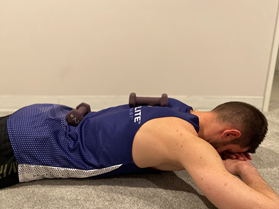Diaphragm Breathing Key Points:
- The diaphragm is essential for proper breathing and stabilization of the spine.
- Chest breathing is usually a form of compensation to deficient diaphragm function.
- Poor breathing can result in faulty moving patterns and pain but can also be a resultant from poor postural positions and pain.
- Diaphragmatic breathing is a great tool that can be used during multiple tasks.
- Make sure the inhalation is around 3 seconds and through the nose. Exhalation is around 4 seconds and through the mouth.
Take a deep breath. What do you notice? Does your chest rise up and outward? Does your belly move at all? Do you inhale through your nose or your mouth? Is it hard to get the air in?

Breathing is a basic function of human life that we never put thought into as it just happens.
We rely on our breath cycle to operate smoothly while we engage in all types of activity but we never really think about its correlation with our function and efficiency. Could we possibly become better at what we do through improving our breathing?
In this article we will talk about proper breathing and its benefits towards human function in ways we may have not considered before.
Chest Breathing Versus Diaphragm Breathing
Believe it or not, most of us are not breathing properly. Most people are chest breathers; meaning we are predominantly inhaling and exhaling through our chest muscles.
With this method, we are neglecting the use of our diaphragm, which is an essential component of a proper breath cycle. Breathing has been analyzed for centuries through various martial arts and yoga practice.
Currently there is more focus on breathing and its relation to recovery from stress and improvements with sleeping.
Breathing dysfunction can be correlated with our everyday life habits involving increased sitting, sedentary jobs, driving and limited physical exertion.
These posture positions and activities tend to promote mechanics that work against proper breathing.
What is the diaphragm and why is it important?
The diaphragm is a dome shaped musculotendinous structure that contracts during inspiration and helps to expand the lungs.
When the diaphragm doesn’t work properly, accessory muscles, which are not as efficient in this process, have to compensate, resulting in methods such as chest breathing.

Aside from breathing, the diaphragm also functions for mechanical stabilization of the spine.
When the diaphragm contracts, it helps to increase intra abdominal pressure, working with the pelvic and abdominal musculature to increase spinal stiffness and stabilization.
Part of this mechanism is also due to the fact that the diaphragm has sections that connect to the lumbar spine segments.

Studies have demonstrated that individuals with chronic low back pain and SI joint pain have abnormal diaphragmatic movement and positioning during breathing and postural tasks.
Diaphragmatic function changes are also noted with dynamic loading of the limbs in individuals with chronic low back pain.

Pain has been shown to alter muscle function, movement quality and central nervous system response to stimuli.
Abnormal sequencing of breathing can contribute to poor movement quality also resulting in undesirable responses such as increased muscle spasm, compensatory movements, or limited force production which can then in turn result in further increased pain or injury.
Learning how to use the diaphragm properly during normal breathing in various postural positions as well as during exertion can not only help movement efficiency but also aid in reducing injury.
The Best Diaphragm Strengthening Exercises
Crocodile Breathing
A good way to start learning how to use the diaphragm is through crocodile breathing.
This method received its name from the way crocodiles move with their bellies in contact with the ground so they have to breathe through lateral and outward expansion.
The same goes for us in that when our torso region becomes rigid and restricted, we lose that proper expansion. We want to be able to expand our mid section out like a barrel and collapse it back down.
Think about a hand held air blower for a fire.

Lying on our stomach allows us to limit the upward and outward expansion of our chest and focus on lateral and outward expansion of our mid section.

Lying prone on the floor, rest your forehead on your hands.
- Make sure that your head is relaxed and your arms are comfortable without shoulder strain. If they feel restricted, lower them down.
- In this position focus on breathing IN through your NOSE for a 3 second count, brief pause and then exhale OUT of your MOUTH at a 4 second count.
- Pause for another 3 seconds and then start the next breath cycle.
Your focus upon inhalation should be on drawing the air in through the nose and down into the belly, attempting to expand your mid section out like a barrel.
Allow your belly to push into the floor and feel your low back rise towards the ceiling.
Upon exhalation, focus on the belly being drawn inward, your low back pulling back inward and the sides of your torso shrinking inward.
- Allow the air to flow slowly out of your mouth.
- Do not force the air out by blowing too fast and do not try to arch your back to push it out.
- This should be very relaxing.
Review: Inhale: Nose: 3 Seconds.
Exhale: Mouth: 4 Seconds
Crocodile Breathing with Weights

Once the regular crocodile breathing method is mastered, you can progress it by using tactile cues of weights.
Assuming the same position, place one weight on your mid back and the other on your low back (small of your back).
- Executing the same technique of inhaling and exhaling, now focus on trying to move the lower weight first upon inhalation and the top weight second upon exhalation.
Side lying Crocodile Breathing
Sometimes through compensation asymmetries result, leaving us with imbalances that can also affect the diaphragm. One side of the diaphragm can expand laterally more efficiently than the other.
This can result from posture habits, sports specific function or works tasks that require dominant use of one limb or side more than the other.
This technique will help to train lateral expansion unilaterally.

Lying on your side with your knees together and slightly bent, head and neck supported with your arms relaxed, place a small soft roll under one side.
- Focus on the same principles with inhalation through the nose for a 3 second count and exhalation out of the mouth for a 4 second count.
- Upon inhalation, focus on expanding your side into the soft roll so you can feel your side come into contact with it.
- Then upon exhalation, focus on drawing your side back up and in, reducing contact with the soft roll.
Hook lying Crocodile Breathing

This progression demands more effort against gravity and requires more focus on controlling the chest from excessively contributing since this position allows extra freedom of the shoulder girdle.
Lying on your back with your feet flat, knees bent and head supported so your neck is neutral, place one hand on your chest and the other on your abdomen right where your belly button is.
- Inhale for 3 seconds through the nose, focusing on driving the belly up into your hand first without your chest hand moving.
- Exhale on a 4 count out of your mouth allowing the belly hand to come back down first without the chest hand moving.
- The belly hand should always move first.
To progress this, place a ball or a small weight on the stomach and focus on moving it in the same manner.

To focus on lateral expansion in this position, place your hands under your bottom ribs, the floating ribs, and upon inhalation; focus on expanding the ribs outward and then upon exhalation back inward.

Goblet Squat Breath Hold

A good way to begin translating these techniques into functional movements especially for strength training is starting with a simple body weight goblet squat.
- Start by placing your hands in the chest and abdomen positions.
- Practice a few breath cycles in standing to ensure you are targeting the diaphragm properly.
- Then slowly begin dropping down into the bottom portion of the squat while inhaling through the nose and focusing on expanding the diaphragm in the same manner.
- Think about making your mid section a barrel.

Then at the bottom portion, exhale again for a 4 second count out of the mouth.
- Pause for 2 seconds, inhale again for 3 seconds, expand the diaphragm and then exhale out of the mouth while drawing the belly inward and rising back to the top.
- You should feel the breathing help you move in and out of the squat position through the force the diaphragm produces at the spine.
Many of these techniques are derived from functionalmovement.com and their corrective exercise date base.
When Is The Best Time To Do Breathing Exercises?
These breathing techniques can be practiced while sitting, standing, before bed, for relaxation and during training such as with weight lifting and plyometric drills.
The real skill comes with executing proper breathing during higher intensity activity such as running, fast paced workouts or heavy lifting.
Neglecting the diaphragm not only compromises our function but also our performance during basic tasks and athletic performance.
Improving our breathing can help with all types of demands while also allowing us to feel better.
About The Author:
Michael St. George PT, DPT has been practicing for 10 years primarily in the outpatient and orthopedic setting. He works for a physical therapist owned private practice based in the greater Philadelphia area and surrounding suburbs. Mike is certified through Functional Movement Systems for FMS, SFMA and FCS which consist of screens and testing used to measure movement quality and performance. Mike also has experience with working with numerous surgeons and physicians from the Rothman institute. Currently he works primarily with ACL, meniscus and post surgical recovery and sports injuries, return to sport testing and performance, running evaluation and re training and hand and upper extremity conditions.
References:
- Functionalmovement.com
- Harper, C., Shahgholi, L., Cieslak, K. (2013) Variability in Diaphragm Motion During Normal Breathing Assessed With B-Mode Ultrasound. Journal of Orthopaedic and Sports Physical Therapy. Vol 43 (12) 927 -931
- Kolar, P., Sulc, J., Kyncl, M., (2012) Postural Function of the Diaphragm in Persons With and Without Chronic Low Back Pain. Journal of Orthopaedic and Sports Physical Therapy. Vol 42 (4) 352-362



